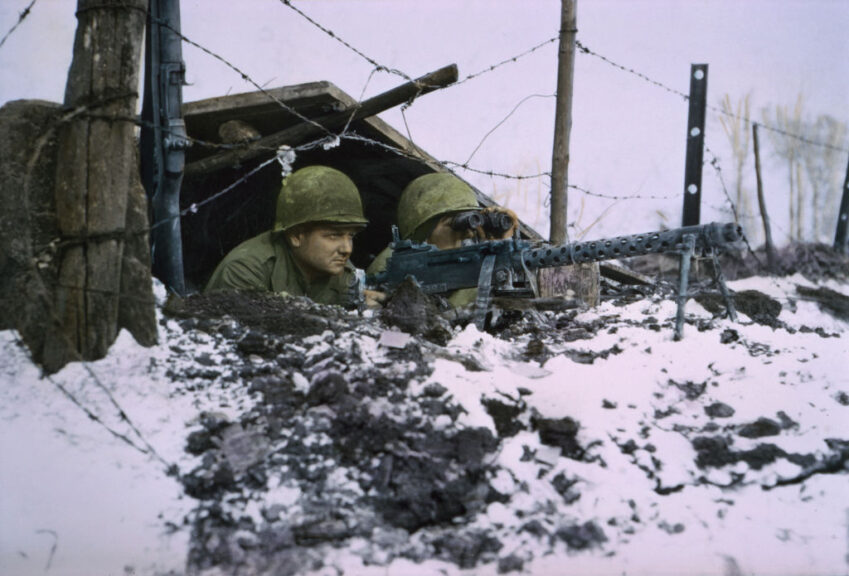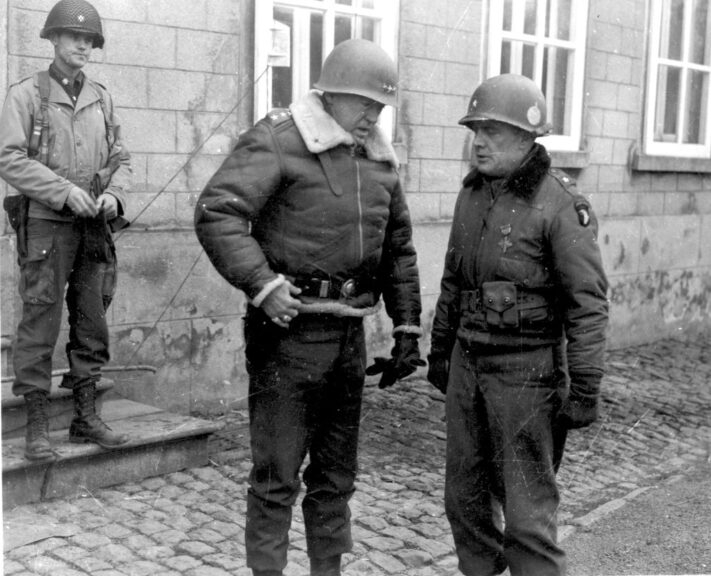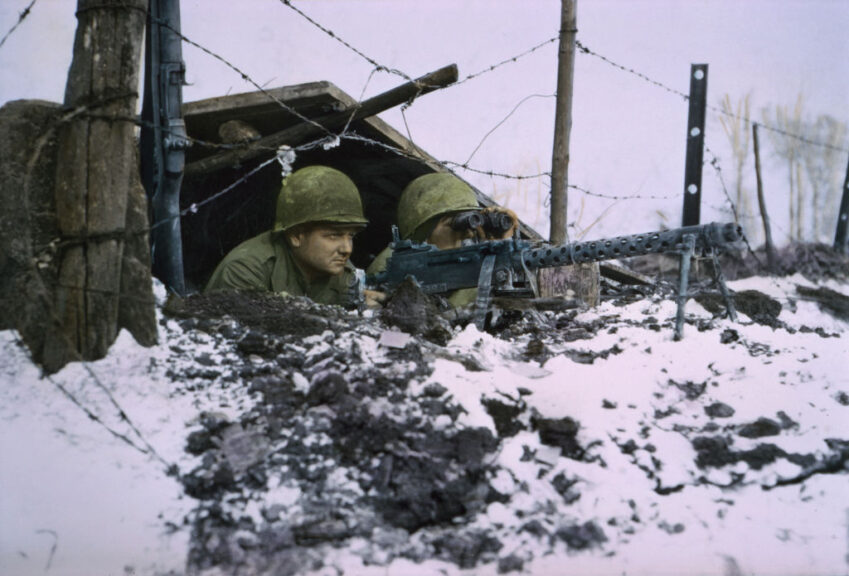No Silent Night: Christmas Eve At The Siege Of Bastogne, 1944
This article was previously published on December 24, 2022.
American service members have often spent their holidays away from loved ones — and in harm’s way — and the men who found themselves in the besieged Belgian city of Bastogne just before Christmas of 1944 were no exception.
Bastogne, which sits just a few miles from the border of Luxembourg, had been under German control since May of 1940 and had only been liberated by Allied troops a few months earlier in September — and much of the 101st Airborne Division remained in and around the city.
Other divisions were scattered throughout the surrounding area, many composed of replacement troops who had only recently arrived in Europe: among them were elements of the 106th Infantry “The Golden Lions,” the 9th Armored “Phantom” Division, and the 28th Infantry “The Bloody Bucket.” Some were still waiting for supply drops, ammunition, and even winter uniforms.
The surprise attack began on December 16th when German Panzer divisions pushed back towards Bastogne, catching the mostly-green American troops in the frozen Ardennes Forest off guard and breaking through roadblock after roadblock. Some put up a good fight, but many were driven back into Bastogne and forced to regroup.
On December 17th, just outside of a nearby town called Malmedy, a Hitler Youth graduate turned Waffen SS (Schutzstaffel) General Joachim Peiper and his men captured over 100 American soldiers, all part of Battery B of the 285th Field Artillery Observation Battalion. After a brief skirmish, the Americans who were unable to escape into the woods surrendered — and after taking their personal possessions from them, Peiper’s men lined the unarmed Americans up in eight rows in a nearby field and opened fire. The few who survived by pretending to be dead recalled hearing laughter as the SS soldiers fired.
50% OFF ALL DAILY WIRE ANNUAL MEMBERSHIPS FOR A LIMITED TIME!
By December 20th, the city of Bastogne itself was under siege, entirely surrounded and vastly outnumbered by the enemy — and word of Peiper and the massacre at Malmedy had gotten to soldiers and civilians alike. Snowy and frigid weather conditions made supply drops all but impossible, and even on the ground, visibility was limited.
Bastogne had also been inundated by “stragglers” — soldiers who had been assigned to units that had been overrun as the Germans had moved to encircle the city — and so Team SNAFU (Situation Normal, All Fouled Up) was born. Men from tank battalions, men from artillery groups, cooks, barbers, it no longer mattered: if they could carry a weapon and stand a post, they were temporarily reassigned to SNAFU and used as much-needed replacements to aid the 101st Airborne.

History Archive/Universal Images Group via Getty Images
Two days into the siege, on December 22nd, a German contingent approached waving a white flag — and delivered an ultimatum to Major Alvin Jones, who commanded the 2nd Battalion, 327th Glider Infantry Regiment.
“The fortune of war is changing. Battalions are ready to annihilate the U.S.A. troops in and near Bastogne,” the letter read. Demanding surrender — within two hours — the German commander threatened to destroy the city if the Americans did not comply. He also promised that the Americans would be blamed for any resulting civilian casualties.
“The order for firing will be given immediately after this two hour’s term,” the German commander wrote. “All the serious civilian losses caused by this Artillery fire would not correspond with the well known American humanity.”
“They want us to surrender,” Jones told Brigadier General Anthony McAuliffe.
McAuliffe, who was acutely aware of the situation, laughed in the face of certain doom: “Aw nuts!”
He went to write a return memo, but told his staff, “I don’t know what to tell them.”
Lt. Colonel Kinnard commented, “Well, sir, that first remark of yours would be hard to beat.”
And so McAuliffe’s reply read simply: “To the German Commander: Nuts! The American Commander.”
Colonel Joseph H. Harper, commander of 327th Glider Infantry, delivered the note to the Germans — reportedly delighting in the chance to explain to them what it meant: “If you don’t understand what ‘nuts’ means, in plain English, it is the same as, ‘Go to Hell.’”
McAuliffe followed that note with an equally blustery Christmas Eve letter to his troops, detailing both the German commander’s demands and his response.
75 years ago this Christmas Eve, Gen. Anthony McAuliffe wrote this letter to his troops during the Battle of the Bulge. Today we remember the service members who served during the holidays both then and now and wish you a Merry Christmas! #NoVeteranEverDies pic.twitter.com/VuYyhYqqVj
— National Cemeteries (@VANatCemeteries) December 24, 2019
“What’s Merry about all this, you ask? We’re fighting — it’s cold, we aren’t home,” McAuliffe’s letter read. “All true but what has the proud Eagle Division accomplished with its worthy comrades the 10th Armored Division, the 705th Tank Destroyer Battalion and all the rest? Just this: We have stopped cold everything that has been thrown at us from the North, East, South and West.”
“We have identifications from four German Panzer Divisions, two German Infantry Divisions and one German Parachute Division,” McAuliffe continued. “These units, spearheading the last desperate German lunge, were headed straight west for key points when the Eagle Division was hurriedly ordered to stem the advance. How effectively this was done will be written in history; not alone in our Division’s glorious history but in World history. The Germans actually did surround us, their radios blared our doom.”
McAuliffe, after sharing his flippant response to the German demand for surrender, concluded with these words: “Allied Troops are counterattacking in force. We continue to hold Bastogne. By holding Bastogne we assure the success of the Allied Armies. We know that our Division Commander, General Taylor, will say: ‘Well Done!’ We are giving our country and our loved ones at home a worthy Christmas present and being privileged to take part in this gallant feat of arms are truly making for ourselves a Merry Christmas.”
The Germans did deliver the promised barrage of artillery and bombs, bringing assault after assault over four days beginning on the 22nd — but on December 26th, a late Christmas gift finally arrived: General George S. Patton and his Third Army severed the German lines completely, breaking the siege of Bastogne.

PhotoQuest/Getty Images


